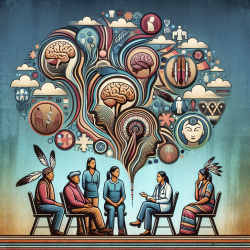Introduction
Schizophrenia is a complex mental disorder that affects individuals worldwide. A recent study titled Schizophrenia and Psychotic Symptoms in Families of Two American Indian Tribes provides valuable insights into the prevalence and characteristics of schizophrenia within two distinct American Indian tribal populations. This research highlights the importance of understanding cultural and environmental factors when diagnosing and treating schizophrenia. As a practitioner, leveraging these insights can enhance your skills and improve the care you provide to diverse populations.
Research Findings
The study examined the prevalence of schizophrenia in two American Indian tribes: a Southwestern tribe and a Plains tribe. The findings revealed that the prevalence rates of schizophrenia within these tribes are consistent with those reported for the general United States population. Specifically, the lifetime prevalence was 8.6 per 1000 in the Southwestern tribe and 3.02 per 1000 in the Plains tribe. These rates are within the normative range, despite the tribes experiencing significant cultural changes and socio-environmental stressors.
Implications for Practitioners
As a practitioner, understanding the cultural context and environmental factors that influence mental health is crucial. The study emphasizes the need to consider sociocultural factors actively before making positive diagnoses of psychosis or schizophrenia. Here are some key takeaways for practitioners:
- Cultural Sensitivity: Recognize that cultural practices and beliefs can influence the expression and interpretation of psychotic symptoms. For example, in some American Indian cultures, visions or auditory experiences may be part of traditional ceremonies and not indicative of a mental disorder.
- Comprehensive Assessment: Use standardized diagnostic criteria while being mindful of cultural nuances. Collaborate with cultural experts or community members to ensure accurate assessments.
- Environmental Considerations: Be aware of the impact of socio-environmental stressors, such as poverty and substance abuse, on mental health. These factors can exacerbate symptoms and should be considered in treatment planning.
Encouraging Further Research
The study highlights the importance of further research into the gene-environment interactions that contribute to schizophrenia. Practitioners are encouraged to engage in research initiatives that explore these interactions within diverse populations. By doing so, we can develop more effective interventions and support systems tailored to the unique needs of different cultural groups.
Conclusion
The occurrence of schizophrenia among the two American Indian tribal groups studied is consistent with prevalence rates reported for most population isolates and the general population. This reaffirms the importance of considering sociocultural factors in diagnosis and treatment. As practitioners, we must strive to enhance our understanding of cultural influences on mental health to provide the best possible care.
To read the original research paper, please follow this link: Schizophrenia and psychotic symptoms in families of two American Indian tribes.










